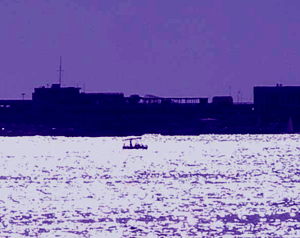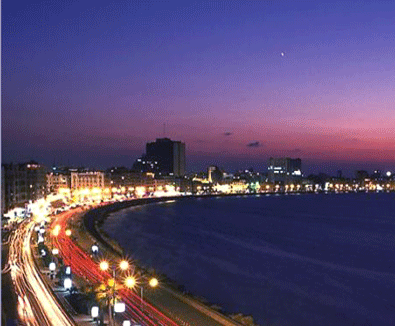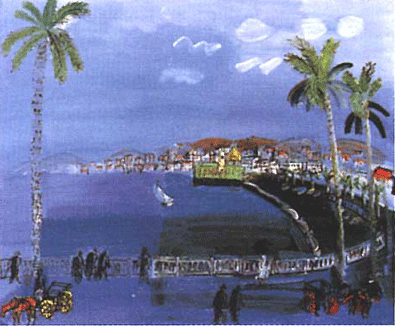Tales of a 21st Century Gypsy
July 15, 2004 Alexandria by night.
I’m in a fish restaurant in Alexandria, a pretty nice one, several floors up in a building on a bit of land that juts into the harbor. The whole sweep of the coastline is around us, deepening blue water and sky as the lights of the city come on at dusk. The windows are open and breezes are coursing through the dining room. At noon Alexandria was baking, but here and now it is deliciously calm and relaxing. Egyptians like to eat late, but this is the best time, as the colors of water and sky shift and the yellow lights of the city begin to glow.

At the next table is a couple with a small boy, going back and forth between Arabic and English. The man – a portly balding fellow – is telling the boy the story of Moses. A prophet, he explains, a messenger of god, but not Mohammed. Listening to his story I’m forced to realize that I don’t know the story of Moses. My ignorance of the culture I was born to is staggering. Something about a servant girl and a baby in the rushes by the Nile. Well, at least I’ve seen those rushes, they are still there. And the ten commandments, of course, and parting the waters of the Red Sea, but that came much later.
Sitting here in the restaurant, the sweep of the corniche reminds me of a Raoul Dufy painting of a bay on the Côte d’Azur. I’m on the other side of the Mediterranean, but there’s the same sweep of water and curve of shoreline, humming peacefully from a distance. From close up, walking along the corniche, the hum rises to a buzz and it’s not as peaceful. I think I see why people hire horse-drawn carriages to take in the atmosphere. It’s the right speed, the right mood, a way to enjoy the liveliness without the bustle and clutter.
When I sat down in the restaurant they brought me – unasked – nine small dishes of mezzah – a salad of cucumber and parsley and tomato, hummos, tahini, baba ghanoush, pickles, beets, and three other spreads I couldn’t identify. One is white and tastes pretty much like a puree of undiluted garlic. Another is pistachio color, the third is orange, perhaps from red peppers. Plus three small loves of pita – “beledi bread,” it’s called here – steaming hot out of the oven across the room. With all that, who needs the fish? But my waiter sent me over to the counter of fishes lying on ice to make my choice. Grilled calamari, which came out of the kitchen hissing and sputtering on a hot iron platter.
I hope he takes it all away soon. If I eat another snippet of calamari or dab of one salad or another I could burst. At the table next to me they have a bowl of raw vegetables as well – halved red peppers, whole cucumbers, even quarters of small red cabbages. Is that just décor? I have no idea what they are going to charge me for this feast. The menu said LE 7 per person for the mezzah assortment, but that made it seem like something you order, not something spirited from the kitchen of its own volition.
Ohmygosh, they just brought the bill. This feast cost me a whopping total of LE 51 – about $8.50. Good grief!
Walking back to the train along the corniche in the dark, the scene was bubbling with energy. The sea walls were lined with people taking the air, talking, eating. Young men sitting close to their robed, veiled girlfrieneds. Groups of slim young women in graceful pants, sweaters, and headscarves. Groups of young men checking out the crowds. Whole families including toddlers and babies. Fathers with their daughters. In Egypt children are out late - it’s not like the US, where they have early bedtimes. Here they nap in the afternoon and hit the town in the evening right along with their parents. The beach that was full of swimming children in the afternoon is being converted to an ephemeral café, tables and chairs set out on the sand in the dark. A few people are still splashing in the water, though, almost invisible in the darkness.
The food vendors have multiplied since the afternoon too. Corn on the cob roasted over hot coals, which smells lovely. I was tempted by it this afternoon, but saved the space for calamari. Light green prickly pears, peeled on the spot for you to eat, if you can keep them from slipping out of your fingers. Roasted seeds – pumpkin, watermelon. Steamed yellow beans that you slip from their shells to eat. Bags of blue and white and pink cotton candy, swinging up high from wooden racks. Ice cream scooped into cups or cones.
 Photo by Volker Banken.
Photo by Volker Banken. Raoul Dufy, La Baie des Anges.
Raoul Dufy, La Baie des Anges.